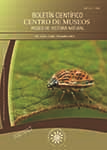Autores/as
Resumen
Con el objetivo de evaluar la capacidad de atracción del salicilato de metilo sobre insectos benéficos (parasitoides y depredadores) presentes en un cultivo de café, se instalaron 20 trampas pegajosas con salicilato de metilo en un lote de 1,6 ha y 20 trampas sin atrayente en un lote testigo de 1,6 ha en el municipio de Taminango, Nariño, Colombia. Éstas fueron evaluadas semanalmente durante 4 meses. Según la prueba de t, las capturas de morfoespecies de las familias Chrysopidae, Ichneumonidae, Perilampidae, Chalcididae, Braconidae, Coccinellidae y otras familias de insectos benéficos, fueron mayores, estadísticamente diferentes a las encontradas en el tratamiento testigo. En el lote con trampas con salicilato de metilo fueron registradas 23 especies, mientras en el lote testigo fueron capturadas 10 especies. Según los resultados del índice de Margalef, fue registrada una mayor diversidad en el lote tratado con salicilato de metilo en relación al lote testigo, un resultado similar fue encontrado con el Índice de Shannon-Wiener (H'). Los resultados indican que el uso de atrayentes químicos puede ser eficiente para aumentar las poblaciones de enemigos naturales, que podrían contribuir en el control biológico natural de las plagas del café.
Palabras clave
Citas
BARRERA, J.; HERRERA, J. & CRUZ, L. 2004. Factores que influyen sobre la captura de la broca del café Hypothenemus hampei con trampas. (en) Resúmenes del I Congreso Internacional sobre Desarrollo de Zonas Cafetaleras. 6-8 de Octubre de 2004, Tapachula. Chiapas, México.
BALDWIN, I.; KESSLER, A. & HALITSCHKE, R., 2001. Volatile signaling in plant- plant- herbivore interactions: what is real?. Curr. Opin. Plant Biol., 5:1-4.
BERNAYS, E. & CHAPMAN, R. 1994. Behavior: the process of host-plant selection. In: Host Plant Selection by Phytophagous Insects. New York USA Chapman and Hall.
BORBÓN, M.; MORA, A.; OEHLSCHLAGER, O. & GONZÁLEZ, L. 2000. Proyecto trampas, atrayentes y repelentes para el control de la broca del fruto de cafeto, Hypothenemus hampei F. (Coleoptera: Scolytidae). (en) XIX Simposio Latinoamericano de Caficultura 2 al 6 de octubre de 2000, San José, Costa Rica.
BROUAT, C.; MCKEY, D.; BESSIERE, J.M.; PASCAL, L. & HOSSAERT-McKEY, M. 2000. Leaf volatile compounds and the distribution of ant patrolling in an ant- plant protection mutualism: Preliminary results on Leonardoxa (Fabaceae: Caesalpinioideae) and Petalomyrmex (Formicidae: Formicinae). Acta Oecol., 21: 349-357
CARMICHAEL, A.; WHARTON, R. & CLARKE, A. 2005. Opiine parasitoids (Hymenoptera: Braconidae) of tropical fruit flies (Diptera: Tephritidae) of the Australia and South Pacific region. Bull. Entomol. Res., 95: 545-569.
GÓMEZ DE LIMA, J.O.; CAMPOS-PEREIRA, R.; MUNIZ DE LACERDA M. P. C.; VIANA-BAILEZ, M.A.M. & VILLACORTA-MOSQUEIRA, A. 2004. Identificação e atratividade de novos voláteis do café cereja e desenvolvimento de armadilha para a coleta massal da broca-do-café, Hypothenemus hampei (Ferr.) (en) Workshop Internacional sobre o Manejo da Broca-do-Café. Londrina, Paraná, Brasil.
GURR, G.M.; WRATTEN, S.D.; ALTIERI, M.A. 2004. Ecological Engineering for Pest Management: Advances in Habitat Manipulation for Arthropods. CABI Publishing, Wallingford, UK.
JAMES, D. 2003a. Field evaluation of herbivore-induced plant volatiles as attractans for benefical insects: Methyl Salicylate and the green lacewing, Chrysopa nigricornisl .J. Chem. Ecol., 29 (7): 1601-1609.
JAMES, D., 2003b. A Synthetic herbivore-induced plant volatiles as .eld attractants for bene.cial insects. (en) The British Crop Protection Council International Congress Crop Science and Technology. Glasgow,Scotland. UK.
JAMES, D. & PRICE, T. 2004. Field-testing of methyl salicylate for recruitment and retention of beneficial insects in grapes and hops. J. Chem. Ecol. 30: 1613–1628.
JAMES, D. 2005. Further evaluation of synthetic herbivore-induced plant volatiles as attractants for bene.cial insects. J. Chem. Ecol., 31, 481–495.
KESSLER, A. & BALDWIN, T. 2001. Defensive function of herbivore-induced plant volatile emissions in nature. Science, 291: 2141-2144.
LA SALLE, J. & GAULD, I. 1991. Hymenoptera: Their Biodiversity, and their impact on the diversity of other organisms. (en) LA SALLE J. & GAULD I. (eds.) Hymenoptera and Biodiversity. C.A.B. International, Wallingfod UK.
MATTHEWS, R.W. 1974. Biology of Braconidae. Annu. Rev. Entomol., 19: 15-32
METCALF, R.L. & LUCKMANN, W.H., 1992. Introducción al manejo de plagas de insectos. Mexico, Noriega.
NORIN, T. 2001. Pheromones and kairomones for control of pest insects. Some current results from a Swedish research program. Pure Appl. Chem., 7(3): 607-612.
OLIVER, I. & BEATTIE, R. 1995. Invertebrade morphospecies as surrogates for species: A Case Study. Conserve. Biol., 10:99-109.
PACKARD, A. 1914. Monograph of the Bombycine moths of North America. Mem. Nat. Acad. Sci., 12: 1-516.
REDDY, G. & GUERRERO, A. 2004. Interactions of insect pheromones and plant semiochemicals. Trends Plant Sci. 9:253-261.
ROWELL, B.; NITTAYAPORN, B.; SATTHAPORN, K.; PHITHAMMA, S. Y. & DOUNGSA-ARD, C. 2005. Hymenopteran parasitoids of Diamondback moth (Lepidoptera: Ypeunomutidae) in northern Thailand. Hortic. Entomol. 98: 449-456.
SARVARY, M A.; NYROP, J.; REISSIG, H. & GIFFORD, K. 2007. Potential for conservation biological control of the oblique banded leafroller (OBLR) Choristoneura rosaceana (Harris) in orchard systems managed with reduced-risk insecticides. Biol Control., 40: 37-47.
SHAW M.R & HUDDLESTON T. 1991. Classification and biology of braconid wasps (Hymenoptera: Braconidae). Handbooks for the Identification of British Insects 7(11):1-126.
TRIPLEHORN, C. A. & JOHNSON, N. F., 2004. Borror and DeLong's Introduction to the study of insects. Belmont CA, Thomson Brooks/Cole.
VAN POECKE, R.; POSTHUMUS, M. & DICKE, M. 2001. Herbivore-induced volatile production by Arabidopsis thalianal leads to attraction of the parasitoid Cotesia rubecula: chemical, behavioral, and gene-expression analysis. J. Chem. Ecol, 27(10): 1911-1928.
VARÓN, E.; HANSON, P.; BORBÓN, O.; CARBALLO, M. & HILJE, L. 2004. Potencial de hormigas como depredadoras de la broca del café Hypothenemus hampei en Costa Rica. Manejo Integrado de Plagas y Agroecología. 73: 42-50.
VILLARREAL, H.; ÁLVAREZ, M.; CÓRDOBA, S.; ESCOBAR, F.; FAGUA, G.; GAST, F.; MENDOZA, H.; OSPINA, M. & UMAÑA, A.M. 2006. Manual de métodos para el desarrollo de inventarios de biodiversidad. Programa de Inventarios de Biodiversidad. Instituto de Investigaciones de Recursos Biológicos Alexander von Humboldt. Bogotá.
ZAR, J.H., 1996. Biostatistical Analysis. New Jersey, USA Prentice Hall.

 PDF
PDF
 FLIP
FLIP



















